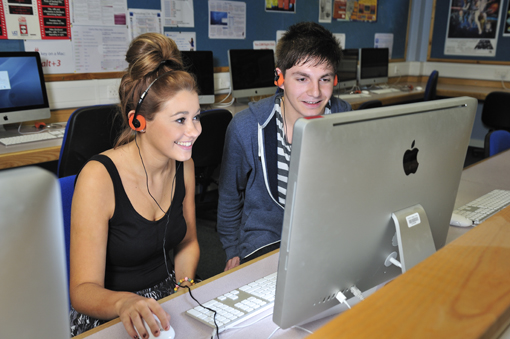 About the author: Anna Levick, Head of Media, New College, Pontefract, explains how the employment of Audio Visual technology to construct student essays and teacher feedback has helped them embrace a digital pedagogy.
E-mail: anna.levick@ncpontefract.ac.uk
About the author: Anna Levick, Head of Media, New College, Pontefract, explains how the employment of Audio Visual technology to construct student essays and teacher feedback has helped them embrace a digital pedagogy.
E-mail: anna.levick@ncpontefract.ac.uk
The employment of Audio Visual technology to construct student essays and teacher feedback
Creative Media is a subject that should be evolving constantly so that it is contemporary and embraces the opportunities that technology may offer. And yet all too often Media is being experienced and taught as a subject that is firmly rooted in the traditional formats of analytical essays and written examinations. This results in a subject that is considered theoretical, unappealing and does not challenge the student to fully engage. Therefore an initiative was launched to take the Media Department of New College, Pontefract away from the more traditional approach and embrace a digital pedagogy.
The students identified that would initially benefit from this initiative were those studying Btec Certificate and Subsidiary Diploma in Creative Media, with the intention that this would ultimately be used by all media students and within the wider college. The students, aged sixteen to nineteen, have a below average GCSE point score of 4.1 - 5, and exhibit many of the traits of under achievement and lack of aspiration as outlined in the AoC report on underachievement (Underachievement in Education of White Working Class Children Association of Colleges & the Sixth Form Colleges’ Association, September 2013). Indeed many of the students are disaffected with education and are hard to motivate. It was hoped that the initiative would improve not only the students’ grades and experience of education but also employability skills and life choices.
The initial stage occurred in 2011 when we transferred all paper resources to the VLE, Moodle, and encouraged students to use the forum spaces as a form of collaborative learning. The department noticed that the students had a greater engagement with the subject material through the creation of this digital and collaborative learning community, creating what we hoped would be ‘a learning environment in which students develop self-regulation and error detection skills’ (John Hattie & Helen Timperley, The Power of Feedback, 2007)
However the forum space still required all members of that community to interact in a written format. While allowances were made so that an appropriate level of informality was acceptable, the restrictions of having to write our conversations became apparent. This was then replicated in written responses to a variety of media texts with mechanical English often hindering the students’ ability to communicate and shifting the teachers’ attention from content to grammar.
To combat this gap between student knowledge and their ability to communicate it, in 2012 it was decided that students would not be submitting research and analytical pieces in written format but rather they would construct audiovisual essays. Students are expected to construct two essays that are rigorous in content and be well constructed using appropriate images, archive footage, text on screen and non-diegetic sound such as music and narration.

This AV approach encourages the student to work in an academic but also creative way, and gives a double decker approach to their time in media. While they are constructing their AV essays they are also developing editing skills, which then improve their original pieces. One Btec Certificate student commented ‘it allowed me to discover the tools on Final Cut Pro and ... to make the mistakes of editing earlier so my creative work was of a higher standard.’
Students of all levels of ability are able to construct the AV essays. For example, students who have dyslexia are able to express themselves without having to worry about their written English and any errors that may occur. In addition, students who may suffer with physical disabilities also find it a much better way to work. The department is providing the students with many layers of learning, experiences and advantages, all of which contribute to them achieving their very deserved high grades.
As the AV essays are individually constructed, it also allows the students to work at their own pace and to explore the software. It provides excellent opportunities for students to be helpful and supportive of each other, turning to their peers to find solutions to problems rather than staff. As such they are developing the soft skills of communication and collaborative working - vital for employment, creating a supportive working environment for all within our learning community.
The use of technology has seen an increase in all aspects of quantifiable evidence – success rates up from 86.6% to 92.2% and High Grades from 63.8 to 72.0 – but also the emotional impact upon the student and their life choices. There are far more students who have achieved places at university to study media in a variety of courses; indeed in one group of Subsidiary Diploma students, the uptake of media to HE level is 50% of the twenty students enrolled.
However the feedback to students was still in the traditional written format and we felt this limited ‘students opportunities and receive information about their performance’ (Hattie & Timperley). Therefore since December 2013 it was felt that the best way to give feedback was in the same way so teachers are now creating feedback in an AV format as specifically mentioned in the Department & college Grade 1 Ofsted inspection in April 2014: ‘In media, teachers have developed innovative and outstanding audio-visual assessments in response to students’ work.’
... this process of giving verbal feedback allows for more effective direction when marking work.
The teacher(s) assessing the work employ QuickTime to record their voices as they watch the student essay. By employing QuickTime, this allows the teacher to pause the essay when and where required and this is recorded, as is whatever is on screen. The feedback is then uploaded to the relevant forum as a reply to the student work. In addition to this, teachers are recording conversations they have with students when looking at work-in-progress. This process of giving verbal feedback allows for more effective direction when marking work. By recording the screen, you can pinpoint specific aspects of the work, and even record a practical demonstration in Photoshop, or record a YouTube demonstration for example. Written feedback does not allow for such demonstrations, and AV feedback frees up the teacher in class, thus making more efficient implementation of the curriculum. This form of feedback both meets the ‘four levels of feedback’ and is one of ‘the most effective forms of feedback ... the forms of video-, audio-, or computer-assisted instructional feedback’ (Hattie & Timperley).
The advantages to the students are:
- It allows the student to listen to rather than read the feedback
- It can be listened to multiple times; the exact part of the essay/production can be seen where improvements may be made
- The feedback is highly personalised for the individual, meeting their specific needs.
In addition to the advantages for the student, staff also benefit as they are employing software they may not use on a day-to-day basis; the feedback provides evidence of individual or paired/team assessment; provides evidence for standardisation and moderation; connects on a more individual and supportive level with the learners as we are able to adopt the appropriate tone and approach of the feedback which is absent in any written format. I also feel that in AV feedback, we are far more detailed, specific and ultimately helpful than we would be in written feedback
The student response to the AV feedback has been very positive and students feel valued for the work they have constructed: ‘you know that your teacher put time and effort into marking and watching your work.’
For staff there has been no significant increase in workload; on average an AV essay is assessed in the same time as a written piece. The advantages include: more individual time with the students in class sessions; specificity of feedback; constant dialogue between staff and students; cements the learning community.
Learners have found their engagement with the subject more focussed, the AV essays and feedback providing them with opportunities to create work that is of a high standard, using real examples that can be analysed in detail and at the same time develop their editing skills. Whilst this approach has demanded that the students work in a very different way to the standard essay writing it has been academically challenging, but ultimately rewarding.
In the future we hope that more departments within the college will adopt this form of working where and when it is appropriate, that other colleges will employ this methodology and ultimately that media as a discipline will lose the pen and deliver and assess in the way media is made, digitally.
Anna Levick